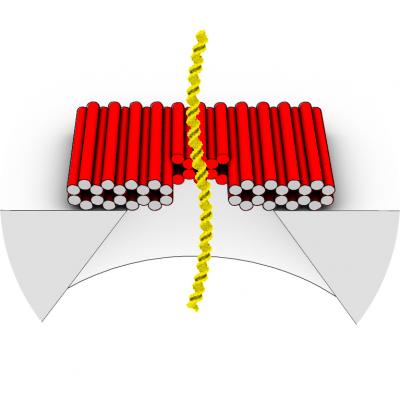domingo, 29 de abril de 2012
DNA Origami Nanoplate Serves as Smart Lid for Solid-State Nanopore Sensor
Technische Universitaet Muenchen (TUM) researchers have used DNA origami to improve the capabilities of solid-state nanopores. They have combined new capabilities for sensing of single-molecules.
The researchers fitted nanoscale DNA-based nanoscale cover plates on to solid-state nanopores. On these plates, DNA origami was used to form central apertures designed for different "gatekeeper" functions.
Bionanotechnology has enabled single-molecule sensitivity for performing label-free protein screening. Researchers belonging to Prof. Hendrik Dietz's group have been improving control over techniques used for DNA origami, while researchers belonging to Dr. Ulrich Rant's group have been investigating the techniques for solid-state nanopore sensors, wherein a biomolecule is made to pass through a hole, which is of nanometer scale in a thin semiconductor slab. The research groups are collaborating for this study.
The concept involves placing a DNA origami "nanoplate" on top of a solid-state nanopore with a conical taper. The plate is placed over the narrow end of the taper. Controlling the aperture size will enable filtration of the desired size of molecules. Single-stranded DNA receptors are placed in the aperture to act as “bait” and this will enable the detection of "prey" molecules in a sequence-specific manner. This can lead to applications for detecting and screening DNA sequences.
The researchers confirmed the self-assembling ability of specially designed DNA origami nanoplates and their placement on solid-state nanopores. Bait/prey detection of particular target molecules and biomolecule size-based filtering were demonstrated.
The ability of DNA origami gatekeepers to allow the passage of small ions may also be an unwanted leakage current in certain applications. DNA sequencing and other applications may have to face such hurdles.
DNA Origami Gatekeepers for Solid-State Nanopores Ruoshan Wei, Thomas G. Martin, Ulrich Rant, and Hendrik Dietz Angewandte Chemie International Edition on-line, April 4, 2012. DOI: 10.1002/anie.201200688
Follow this link for more information.
Suscribirse a:
Comentarios de la entrada (Atom)


No hay comentarios.:
Publicar un comentario